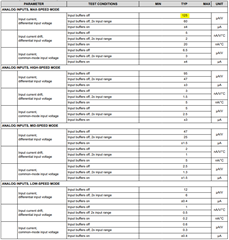Tool/software:
Hello experts,
What is the analog input impedance of this ADC?
Thank you,
Dylan
This thread has been locked.
If you have a related question, please click the "Ask a related question" button in the top right corner. The newly created question will be automatically linked to this question.
Tool/software:
Hello experts,
What is the analog input impedance of this ADC?
Thank you,
Dylan
Hello Dylan,
The input impedance is specified as input current verses voltage and depends on a number of configuration settings. You can take the reciprocal of these values in the specifications section of the datasheet to calculate impedance.
For example, in Max-speed mode, f-CLK=32.768MHz, Input buffers off, 1X input range, the specified input differential current is 125uA/V, which equates to 8kOhm; 1/(125*10^-6). With the input buffers on, the input impedance is approximately 1000x higher, or about 8MOhm. In this case, the input current constant of +/-4uA is the primary current.

Regards,
Keith Nicholas
Precision ADC Applications
Thank you for such a quick reply--it was very helpful! Where did you see the "approximately 1000x higher" number in the datasheet? I see a quoted 99% decrease in current (and therefore 100x increase in impedance) in Section 7.3.1 and a calculated 99.36% decrease in current based on the table you sent (assuming 5V operation: 4/(125*5)). This detail is important because I am looking for an ADC that has >1MOhm input impedance.
Thank you,
Dylan

Hello Dylan,
The input current is made up of differential current that depends on the input voltage (this is the equivalent input impedance) AND additional common mode current that does not change with respect to input voltage. When the input pre-charge buffers are enabled, almost all of the remaining input current is common mode current. This is why we specify an absolute value of input current in uA with the pre-charge buffers ON, and not in terms of uA/V.
The differential input impedance does go up by about 1000x (we do not mention this in the datasheet) but you will still have the remaining common mode current, which is specified in the tables.
The pre-charge buffers are intended to reduce the bandwidth requirements of an external input amplifier, not to eliminate the need for an external amplifier. If your input source has a very low input impedance, you could directly drive the ADC inputs, but in general, you will want to include an input amplifier for each of the channels. If adding an external amplifier for each channel is not an option, then I would suggest purchasing an evaluation board and validating performance with your input source.